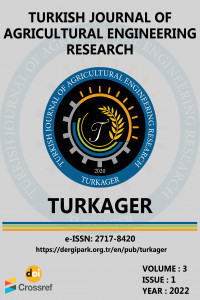Karnabaharın (Brassica oleracea L.) Model ve Kantitatif Renk Kalite Özelliklerine Kurutma İşlemlerinin Etkisi
Kurutma, Modelleme, Renk, Karnabahar
The Effect of Drying Processes on Model and Quantitative Color Quality Characteristics of Cauliflower (Brassica oleracea L.)
Drying, Modeling, Color, Cauliflower,
___
- Adiletta G, Iannone G, Russo P, Patimo G, De Pasquale S and Di Matteo M (2014). Moisture migration by magnetic resonance imaging during eggplant drying: A preliminary study. International Journal of Food Science and Technology, 49: 2602-2609.
- Alibas I and Koksal N (2015). Forced-air, vacuum, and hydro precooling of cauliflower (Brassica oleracea L. var. botrytis cv. Freemont): part II. Determination of quality parameters during storage. Food Science Technology (Campinas), 35: 45-50.
- Baloch AB, Xia X and Sheikh SA (2015). Proximate and mineral compositions of dried cauliflower (Brassica oleracea L.) grown ın sindh, Pakistan. Journal of Food and Nutrition Research, 3(3), 213-219.
- Çelen İH, Çelen S, Moralar A, Buluş HN ve Önler E (2015). Mikrodalga bantlı kurutucuda patatesin kurutulabilirliğinin deneysel olarak incelenmesi. Electronic Journal of Vocational Colleges- Special Issue: The Latest Trends in Engineering, 5(4): 242-287.
- Di Scala KC and Crapiste GH (2008). Drying kinetics and quality changes during drying of red pepper. LWT- Food Science and Technology, 41(5): 789-795.
- Gülçimen F (2008). Yeni tasarlanan havalı kollektörler yardımı ile reyhan ve nane kurutulması. Doktora Tezi, Fırat Üniversitesi, Fen Bilimleri Enstitüsü, Makine Eğitimi Anabilim Dalı, s. 169, Elazığ.
- Krokida M and Maroulis Z (2000). Quality changes during drying of food materials. Drying Technology in Agriculture and Food Sciences, 4(2): 61-68.
- Krokida MK, Kiranoudis CT, Maroulis ZB and Marinos Kouris D (2000). Effect of pretreatment on color of dehydrated products. Drying Technology, 18(6): 1239-1250.
- Lewis WK (1921). The rate of drying of solid materials. Industrial Engineering Chemistry, 13: 427-443.
- Marques LG, Silveira AM and Freire JT (2006). Freze-Drying characteristics of tropical fruits. Drying Technology, 24: 457-463.
- McGuire RG (1992). Reporting of objective color measurements. HortScience, 27: 1254-1255.
- Page GE (1949). Factors influencing the maximum rates of air drying shelled corn in thin layers, MSc. Thesis, Master Thesis, Purdue University, Graduate School of Natural and Applied Sciences, Department of Mechanical Engineering, Indiana.
- Plou E, Lopez Malo A, Barbosa Canovas GV, Welti Chanes J and Swanson BG (1999). Polyphenoloxidase activitiy and color of blanced and high hydrostatic pressure treated banana puree. Journal of Food Science, 64: 42-45.
- Polatcı H, Taşova M ve Saraçoğlu O (2020). Armut (Pirus communis L.) posasının bazı kalite değerleri açısından uygun kurutma sıcaklığının belirlenmesi. Akademik Platform Mühendislik ve Fen Bilimleri Dergisi, 8(3): 540-546.
- Rahman R and Gani M (2019). Effect of different pre-treatments and drying techniques on quality of cauliflower. Annals. Food Science and Technology, 20(2): 207-217.
- Sagar VR and Kumar PS (2010). Recent advances in drying and dehydration of fruits and vegetables: A review. Journal of Food Science and Technology, 47(1): 15-26.
- Şahin M and Doymaz İ (2017). Estimation of cauliflower mass transfer parameters during convective drying. Heat Mass Transfer, 53: 507-517.
- Şahin M (2014). Brokoli ve karnabaharın kurutma karakteristiklerine ön işlem sıcaklığının ve süresinin etkisi. Yüksek Lisans Tezi, Fen Bilimleri Enstitüsü, Kimya Mühendisliği Ana Bilim Dalı, s. 101, İstanbul.
- TÜİK (2021). Türkiye İstatistik Kurumu. http://www.tuik.gov.tr, (01.04.2022)
- Vargas L, Kapoor R, Nemzer B and Feng H (2022). Application of different drying methods for evaluation of phytochemical content and physical properties of broccoli, kale, and spinach. LWT-Food Science and Technology, 155, 112892.
- Vega Gálvez A, Di Scala K, Rodríguez K, Lemus Mondaca R, Miranda M, López J and Perez Won M (2009). Effect of air-drying temperature on physico-chemical properties, antioxidant capacity, colour and total phenolic content of red pepper (Capsicum annuum, L. var. Hungarian). Food Chemistry, 117(4): 647-653.
- Wang CY and Singh RP (1978). A single layer drying equation for rough rice. ASAE Paper No: 78-3001, ASAE, St. Joseph, MI.
- Yağcıoglu A (1999). Tarımsal ürünleri kurutma tekniği. Ege Üniversitesi Ziraat Fakültesi yayınları No: 536. Bornova, İzmir.
- Yıldız Turgut D ve Topuz A (2020). Depolama süresinin farklı kurutma yöntemleri ile kurutulmuş kamkat dilimlerinin bazı kalite özelliklerine etkisi. Yüzüncü Yıl Üniversitesi Tarım Bilimleri Dergisi 30(1): 44-56.
- Yayın Aralığı: Yılda 2 Sayı
- Başlangıç: 2020
- Yayıncı: Ebubekir ALTUNTAŞ
Development of Olive Harvesting Machine by Shaking
Mohamed GHONİMY, Samy YOUNİS, Elsayed GHONİEM
Farmers' Participation in Watershed Management in Sodo Zuria District of Southern Ethiopia
Danıel BALTA, Senapathy MARİSENNAYYA, Pandikumar M MARISENNAYYA, Chinaza GODSWİLL AWUCHİ
Effect of Fermentation on Drying Characteristics of Three Varieties of Trifoliate Yam
Ide PATRICK EJIKE, Ugwuanti-nnadi OBİAGELİ, Eje Brendan EKETE
Improving the Nutritional and Functional Properties of Pearl Millet Pasta: A Review
Kirti JALGAONKAR, Manoj MAHAWAR, Sharmila PATİL, Jyoti DHAKANE LAD
Fuel Properties of Sandbox (Hura crepitans Linn.) Methyl Ester and its Blends
David ONWE, Adeleke Isaac BAMGBOYE
Christopher OBİNECHE, Patricia ORİAKU
Diyabetik Bal Kabağı (Cucurbita moschata Duch.) Marmelatı Üretimi
